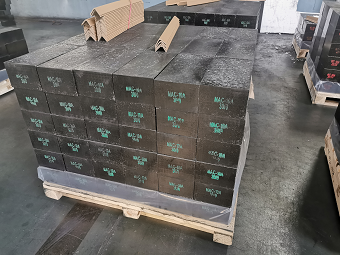Kiln refractory magnesia carbon brick
Magnesia-carbon bricks are made of magnesia, dead-burned magnesia, fused magnesia, high-purity magnesia, and high-quality graphite and bauxite additives. The price of magnesia-carbon bricks and their performance has a lot to do with the graphite content in the bricks. As the graphite content increases, the strength of the brick decreases the thermal expansion rate decreases, and the residual expansion rate increases.
Therefore, the graphite content in the brick should be controlled at about 20%. Magnesia-carbon bricks have low wettability to slag and have excellent resistance to spalling and erosion. They are suitable for the slag line of the ladle, especially in the case of multi-furnace continuous casting. In order to meet the needs of producing clean steel, the application part of magnesia-carbon bricks has been expanded from the slag line to the side wall during refining in the ladle.
When laying magnesia-carbon bricks on the ladle, care should be taken not to mix with bricks containing high SiO2. Otherwise, the local melting loss of magnesia-carbon bricks will be increased, and the melting loss mechanism is:
Kiln refractory magnesia carbon brick is mainly used for the lining and tapping port of the steel-making oxidation reformer, the hot spot of the furnace wall of the high-power electric furnace, and the lining of the refining furnace outside the furnace, the slag line of the steel ladle, etc.
In the smelting process, the use conditions and damages of various parts of the converter are different. In order to achieve balanced corrosion loss, the grades and qualities of magnesia-carbon bricks selected are also different for each part of the converter under different conditions of use.

The temperature of the furnace mouth and furnace cap changes sharply, and the slag corrosion is more serious. Magnesia-carbon bricks with good thermal shock resistance and strong slag resistance should be selected. Except for the damage caused by blowing, the two sides of the trunnion have no mold slag layer cover on the surface, which is not easy to repair, and the carbon in the brick is easily oxidized. High-quality magnesia-carbon bricks with excellent slag resistance and good oxidation resistance should be built. The slag line is in contact with the molten slag for a long time and is seriously corroded by the slag. It is necessary to build magnesia-carbon bricks with excellent slag resistance. The splashing effect of slag and molten steel when oxygen is blown on the charging side is likely to cause chemical erosion, abrasion, scouring, and direct impact and erosion of the scrap and molten iron on the charging side. Magnesia-carbon bricks with strong slag resistance, high-temperature strength, and good thermal shock resistance should be selected. Compared with other parts, the hearth and furnace bottom are less eroded, and ordinary magnesia-carbon bricks can be used. When the top-bottom composite blowing technology is used, especially when gases such as CO2 and O2 are blown at the bottom, the damage is more serious. High-grade magnesia-carbon bricks with good oxidation resistance, good thermal shock resistance, high-temperature strength, and strong slag resistance should be selected. According to the use of different parts of the converter, the selection of converter magnesia-carbon bricks with corresponding performance is an effective method to improve the technical and economic indicators of the converter
The raw material for preparing magnesia-carbon bricks is fused magnesia with a MgO content of 98%, magnesia-carbon bricks are characterized by their low porosity, slag erosion resistance, thermal shock resistance, and high-temperature strength, and they are mainly used for Basic oxygen furnaces, mid-range magnesia, ladle slag lines and electric arc furnace hotspots. Magnesia carbon brick is a high-quality refractory material. Their main components are magnesium oxide and carbon, where the magnesium oxide content is 60-90% and the carbon content is 10-40%. This material is made of high-purity magnesium oxide particles, carbon material, tar, pitch, or resin baked at high temperatures. These magnesia refractory bricks have the characteristics of slag corrosion resistance, thermal shock resistance, thermal conductivity, and so on.
Magnesia carbon brick is an unburned carbonaceous composite refractory material, which is made of high melting point (2800 ℃) basic oxide magnesium oxide and high melting point carbon material, which is difficult to be corroded by slag and added. Various non-oxide additives and carbon binders.
The magnesia contained in magnesia-carbon bricks is determined according to what material is used. Common magnesia-carbon bricks are mainly 72% magnesia, 74% magnesia, 76% magnesia, 80% magnesia, 82% magnesia, 85% magnesia % magnesia, ladle magnesia-carbon bricks, the main raw materials used in the production of magnesia-carbon bricks are fused magnesia, graphite, metal aluminum powder, metal silicon powder, and liquid phenolic resin, which are stirred by a sand mixer and pressed by a press. Carbon bricks are used in refining ladle slag lines, and magnesia carbon bricks are also used in furnace linings such as AC electric arc furnaces, DC electric arc furnaces, and converters.
Electric furnace magnesia-carbon brick steelmaking is equipment that uses the electric arc generated between the graphite electrodes as a heat source for steelmaking.
-

Silicate fire brick
Silicon thermal insulation refractory brick refers to the thermal insulation refractory products made of silica as the main raw material, with a SiO2 content of no less than 91%. In addition to the heat insulation perfor··· -

silica bricks manufacturing process
1.1 Determination of raw material ratio and particle compositionThe raw materials for making silica bricks are silica and waste bricks containing more than 96% SiO2, in addition to lime, mineralizers and organic binders.··· -

Alumina hollow ball bricks
Alumina hollow ball bricks are made of alumina hollow balls and alumina powder as the main raw materials, combined with other binders, and fired at a high temperature of 1750 degrees. It belongs to a kind of ultra-high t··· -

Anti-stripping high alumina brick for cement kiln
Anti-stripping high alumina bricks are made of high alumina bauxite clinker, mullite, kyanite, zircon sand, and binder first through granulation and powdering processes, mixed in a certain proportion, then pressed into s···

